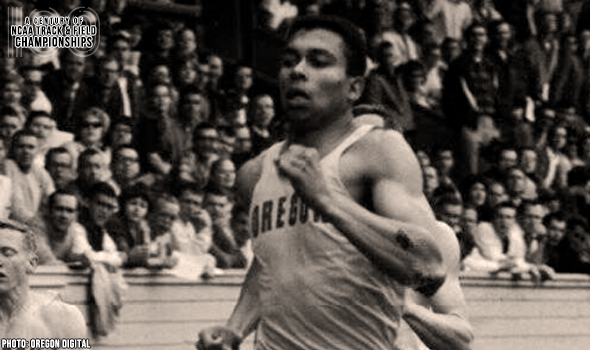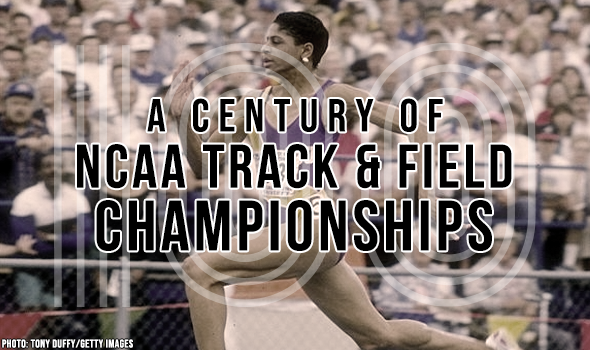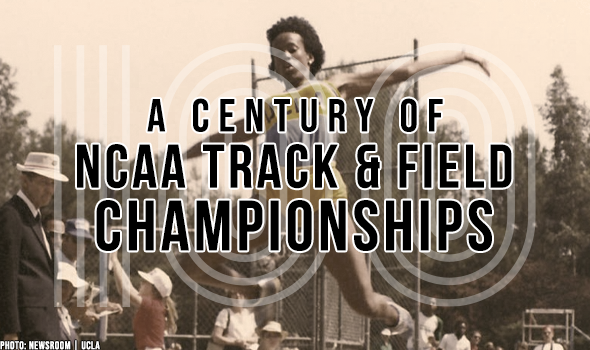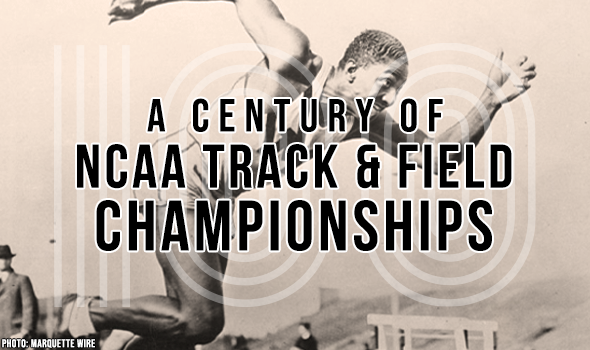
Oregon’s Jerome Sprinted To NCAA Glory
If ever a meet could have used photo-finish timing, it was the 1964 NCAA Outdoor Track & Field Championships.
The 5000 and 400 were both ruled deadlocks, but those were with merely two runners inseparable.
The 100-meter final saw three sprinters crossing the line at almost the same instant: Harry Jerome of Oregon, Edwin Roberts of North Carolina Central and Trenton Jackson of Illinois.
It took almost an hour to sort the finish, but when they did, Jerome was ruled the victor in 10.1. Roberts (second) and Jackson (third) were also credited with that same mark as well.
“Honestly, that’s one I’d hate to judge on,” Jerome said about the finish to Dick Leutzinger of the Eugene Register-Guard. “Usually I know when I win or lose. I’d hate to say on that one.”
While the 10.1 was a meet and collegiate record, it wasn’t a PR for Jerome. He still owned a share of the world record of 10.0 that he set in the summer after his freshman season back in 1960.
Jerome was a Canadian prodigy who came from great lineage. As a high school standout in North Vancouver, British Columbia, he broke a 31-year-old national record in the 220 yards. And many knew his grandfather, John Armstrong Howard, who was the first Black athlete to represent Canada in the Olympic Games.
The fact that Jerome was even running in 1964 – near his best, let alone at all – was a comeback story for the ages. Jerome tore his quadriceps tendon in the fall of 1962 at the British Commonwealth Games and the seriousness of the injury led many to believe that he would never run again. He didn’t believe that and a little over a year later, he opened the 1964 season by equaling the world indoor best in the 60-yard dash with his time of 6.0.
Then at the 1964 NCAA Championships, Jerome doubled back in the 200, taking third to lead Oregon to its second team title in three years – both at Hayward Field. The Ducks won their first national title in 1962 when Jerome won the 220 yards and was runner-up in the 100.
Not long after that, Jerome went to the Tokyo Olympic Games, where he earned his lone Olympic medal – a bronze in the 100.
Jerome died in 1982 of a brain aneurysm at age 42. In 1984, the Labatts Classic held in Burnaby was renamed the Harry Jerome Classic and in 1988 a statue of him was erected in Vancouver’s Stanley Park.
The NCAA and collegiate track & field will mark a momentous milestone in the spring of 2021 -- the 100th anniversary of the NCAA Championships and with that, the NCAA Track & Field Championships. In June 1921, the University of Chicago hosted the first track & field championships in NCAA history.
This point can’t be emphasized enough: Not only was the event the first for NCAA track & field, but the first championships for any sport under the sponsorship of the NCAA.
To celebrate, over each of the next 365 days, the U.S. Track & Field and Cross Country Coaches Association (USTFCCCA) will celebrate moments, student-athletes, and coaches that have made a century’s worth of championships special. From humble beginnings to important historical milestones to the modern-day, collegiate track & field has evolved with the American society.
The 2021 edition of the NCAA Division I Outdoor Track & Field Championships begin with preliminary round action on May 27-29 in Jacksonville, Fla., and College Station, Texas. The championships final site and culmination of the celebration is slated for June 9-12, 2021 at the newly rebuilt Hayward Field in Eugene, Ore.

Cal’s Hudson Wins Epic Triple Jump With World’s Best
On this day in 1987, Sheila Hudson of California set world best in Women’s Triple Jump at the NCAA Division I Outdoor Track & Field Championships when she bounded 13.78m (45-2½).

Track. Field. Houston’s Lewis Does It All!
On this day in 1981, Carl Lewis of Houston became the first athlete since Jesse Owens to win a track event and field event at the same NCAA Division I Outdoor Track & Field Championships.

UCLA Men’s 4×400 Clocks NCAA’s First Sub-3
On this day in 1988, the UCLA men’s 4×400 relay team became the first collegiate quartet to break three minutes, clocking 2:59.91 with Steve Lewis, Kevin Young, Danny Everett and Henry Thomas.

LSU’s Sowell Dominates 1989 NCAA Championships
On this day in 1989, Dawn Sowell of LSU culminated one of the most dominant performances in the history of the NCAA Outdoor Championships.

Givens’ Quad Leads Florida State to Team Title
On this day in 1984, Randy Givens of Florida State completed a remarkable – and still, unmatched – feat, winning a quadruple set of titles at the NCAA Division I Outdoor Track & Field Championships in Eugene, Ore.

Rono Rolls Into The Record Books
On this day in 1978, Henry Rono of Washington State became the first (and still only) man to set two different NCAA Championships meet records in distance races on the same day.

Jackie Joyner Doubles Down On Multi Crowns
On this day in 1983, Jackie Joyner of UCLA became the first woman to win an event twice at the NCAA Championships, claiming her second consecutive crown in the heptathlon with a then-collegiate-record-setting score of 6390 points.

Connect Four: Prefontaine Makes History
Steve Prefontaine of Oregon became the first athlete to win titles in the same outdoor event four times, claiming the 3-mile/5000m from 1970-73.

Ralph Metcalfe Is Mr. Triple-Double
Ralph Metcalfe, who was born on this day (May 29) in 1910, won three consecutive 100 and 200 titles while at Marquette from 1932-34, becoming the first athlete to win three NCAA titles in two separate events.

Georgia’s Orji Jump-Starts Record-Breaking Career
On this day in 2016, Keturah Orji of Georgia set her first collegiate record in the triple jump of 14.29m (46-10¾) at the NCAA Division I East Preliminary Round in Jacksonville, Florida.

